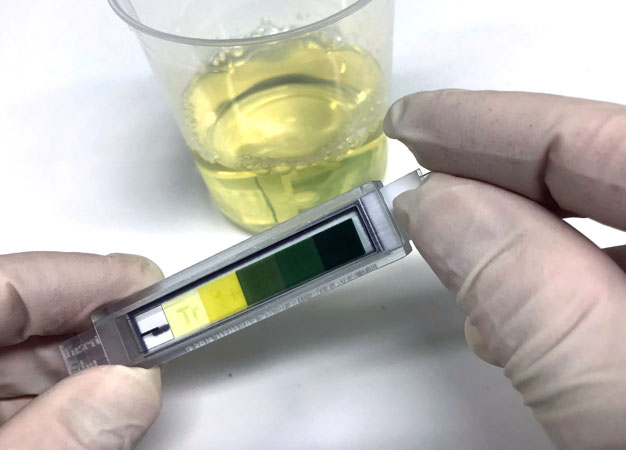Inkjet printing technology transforms ordinary filter paper into devices that can spot kidney disease or contaminated water
Published online 22 March 2018

Reading the results of home urine tests can be challenging. Daniel Citterio and his team have developed a system that makes it much easier to interpret results.
© 2018 Daniel Citterio
Paper-based analytical devices have come a long way from old-fashioned litmus strips used to measure pH. Advanced printing techniques now enable quick, accurate testing for multiple chemical or biological agents on substrates that cost just pennies to produce. Researchers at Keio University are showing how the efficient display of color-based information may take such paper-based devices out of the lab and into the real world for applications including medical and environmental diagnostics1,2.
Guiding flow using water-repelling inks
When water droplets come into contact with conventional filter paper, they spread uncontrollably in all directions as they absorb. To direct the flow of samples such as tiny blood drops, Daniel Citterio from Keio University and his team employ microfluidic patterning techniques based on water-repelling inks. "We create hydrophobic barriers using common inkjet or solid wax ink printers," explains Citterio. "These barriers are three dimensional, extending throughout the thickness of the paper, and so they guide the liquid where we want it to go."
Citterio and his co-workers specialize in paper analyzers that indicate the presence of specific compounds through vivid color changes. One recent project involved creating optical electrodes, or 'optodes', that identify aqueous ions such as sodium, making them useful for various applications, including water monitoring.
Optodes are also extremely sensitive to pH because they rely on the exchange of protons against the target cation to initiate a color change. But this sensitivity normally requires users to simultaneously measure pH and apply a correction to the sample. "One big advantage of paper is that you can put almost anything on it, including a pH buffer," notes Citterio. By incorporating the buffer layer into their device, the researchers ensured it automatically adjusts for varying chemical conditions, including those arising from cellulose in the paper substrate.
Most devices direct water along the paper's surface, but the team obtained better results when droplets were driven vertically. "Since optode membranes are highly hydrophobic, liquids will try to avoid these zones in lateral channels," says Citterio. "However, top-down flow forces the liquid to contact the hydrophobic area, generating stronger color signals."
Simpler testing of urine
Another diagnostic device developed by the Keio researchers aims to improve a basic diagnostic tool ― the urine dipstick. Their device alters color in response to different protein levels. "People normally don't have urine dipsticks at home because the color change is quite faint," says Citterio. "But if used correctly, they can indicate signals of kidney disease. Doctors tell us that they can do more for patients with earlier warnings."
To avoid such uncertainties, the team developed a text-displaying dipstick. Using inkjet printers and a special ink that changes color at different biomolecular concentrations, they printed symbols signifying different levels of protein: from 'trace' to '+4'. The paper device is then inserted into the lower portion of three-dimensional printed housing, and a screening film is placed on top to hide the text. Briefly immersing these devices into urine samples demonstrated that this approach can give the same accuracy as commercial dipsticks but with read-outs that are far simpler to interpret.
"This could benefit people with color vision anomalies," notes Citterio. "And this same concept could be applied to any type of colorimetric indicator. As long as you can read, you can't go wrong."
About the researcher

Daniel Citterio― Professor
Department of Applied Chemistry, Faculty of Science and Technology
Daniel Citterio obtained his doctorate from ETH Zurich in 1998. After doing postdoctoral research in Japan and working for a while in industry, he became an associate professor at the Department of Applied Chemistry of Keio University in 2009 and full professor in 2014. He heads the Laboratory for Analytical Chemistry.
Links
References
- Shibata, H., Henares, T. G., Yamada, K., Suzuki, K. & Citterio, D. Implementation of a plasticized PVC-based cation-selective optode system into a paper-based analytical device for colorimetric sodium detection. Analyst 143, 678-686 (2018). | article
- Yamada, K., Suzuki, K. & Citterio, D. Text-displaying colorimetric paper-based analytical device. ACS Sensors 2, 1247-1254 (2017). | article